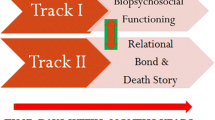Conclusion
If the joy and pleasure of intimate, caring relationships are accepted, then we must have the courage to grieve for their loss. Physicians and other helping professionals have access to the family at this critical time in the life cycle. This is an opportunity to influence the system, to be the “nonanxious presence” that promotes healing. To meet this opportunity, helpers need to invest of themselves and assist the bereaved to express powerful feelings in the context of a supportive environment. It is necessary to be aware of the increased health risks of the bereaved and prepared to intervene to prevent excess mortality. The outcomes of these interventions must be studied so the next generation of helping professionals will not have to learn by trial and error and personal experience.
Access this article
We’re sorry, something doesn't seem to be working properly.
Please try refreshing the page. If that doesn't work, please contact support so we can address the problem.
Similar content being viewed by others
References
Friedman EH. General to generation. New York: The Guilford Press, 1985.
Rhodes S, Wilson J. Surviving family life. New York: G. P. Putnam’s Sons, 1981.
Carter EA, McGoldrick M. The family life cycle. New York: Gardner Press, Inc., 1980.
Ball JF. Widow’s grief: the impact of age and mode of death. Omega (Westport) 1977; 4:307–33.
Boshes B. Death: historical evolution and implication of the concept. Ann, NY Acad Sci. 1978; 315:11–18.
Hauser MJ. Bereavement outcome for widows. J Psychosoc Nurs Ment Health Serv. 1983; 9:22–31.
Claypool J. Tracks of a fellow struggler. Waco, Texas: Word, Inc., 1974.
Schulz R. The psychology of death, dying and bereavement. Reading, MA: Addison-Wesley Publishing Co., 1978: Chapter 6.
Brown JT, Stoudemire GA. Normal and Pathological grief. JAMA. 1983; 3:378–82.
Zisook S, Shuchter SR. Time course of spousal bereavement. Gen Hosp Psychiatry. 1985; 7:95–100.
Levine S. Healing into life and death. Garden City, NY: Anchor Press/Doubleday, 1987.
Olson PR, Suddeth JA, Peterson PJ, et al. Hallucinations of widowhood. J Am Geriatr Soc. 1985; 33:543–47.
Parkes CM, Brown RJ. Health after bereavement: a controlled study of young Boston widows and widowers. Psychosom Med. 1972; 5:449–61.
Rosenbaum J. Widows and widowers and their medication use: nursing implications. J Psychosoc Nurs Ment Health Serv. 1981; 19:17–9.
Windholz MJ, Marmar CT, Horowitz MJ. A review of the research on conjugal bereavement: impact on health and efficacy of intervention. Compr Psychiatry. 1985; 5:433–47.
Helsing KJ, Szklo M, Comstock GW. Factors associated with mortality after widowhood. Am J Public Health. 1981; 8:802–9.
Rees WD, Lutkins SG. Mortality of bereavement. Br Med J. 1967; 4:13–6.
Mellstrom D, Nilsson A, Oden A, Rundgren A, Svanborg A. Mortality among the widowed in Sweden. Scand J Soc Med. 1982; 10:33–41.
Jacobs S, Ostfeld A. An epidemiological review of the mortality of bereavement. Psychosom Med. 1977; 5:344–57.
Kestenbaum B, Diez G. Mortality of older widows and wives. Social Security Bull 1982; 10:24–7.
Wechsler R. A new prescription: mind over malady. Discover. 1987; 7:50–61.
Solomon GF, Amkraut AA, Kasper P. Immunity, emotions and stress. Psychother Psychosom. 1974; 23:209–17.
Paulley JW. Pathological mourning: a key factor in the psychopathogenesis of autoimmune disorders. Psychother Psychosom. 1983; 40:181–90.
Targum SD, Sullivan AG, Byrnes SM. Neuroendocrine interrelationships in major depressive disorder. Am J Psychiatry. 1982; 3:282–6.
Calabrese JR, Kling MA, Gold PW, et al. Alterations in immunocompetence during stress, bereavement and depression: focus on neuroendocrine regulation. Am J Psychiatry. 1987; 144:1123–34.
Schleifer SJ, Keller SE, Sirus SG, et al. Depression and immunity. Arch Gen Psychiatry. 1985; 42:129–33.
Schleifer SJ, Keller SE, Camermo M. Suppression of lymphocyte stimulation following bereavement. JAMA. 1983; 250:374–7.
Bartrop RW, et al. Depressed lymphocyte function after bereavement. Lancet. 1977; i:834–6.
Author information
Authors and Affiliations
Rights and permissions
About this article
Cite this article
Olson, P.R., Cooper-Goloenberg, J. & Sturgis, J. Surviving bereavement. J Gen Intern Med 4, 259–262 (1989). https://doi.org/10.1007/BF02599534
Issue Date:
DOI: https://doi.org/10.1007/BF02599534




